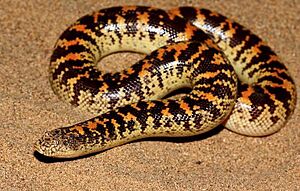Eryx jayakari facts for kids
Quick facts for kids Eryx jayakari |
|
|---|---|
 |
|
| Conservation status | |
| Scientific classification | |
| Genus: |
Eryx
|
| Species: |
jayakari
|
The Arabian sand boa (also called Eryx jayakari) is a type of snake. It belongs to the Boidae family, which includes boas. This snake lives only in the Arabian Peninsula and Iran. It spends its days hidden deep in the sand.
Contents
What's in a Name?
The scientific name, jayakari, and one of its common names, Jayakar's sand boa, honor a person. They are named after Atmaram Sadashiv Jayakar. He was an Indian surgeon and a naturalist. A naturalist is someone who studies nature.
Meet the Arabian Sand Boa
The Arabian sand boa is a small snake. It grows to about 38 centimeters (15 inches) long, including its tail. Its eyes are very tiny and sit on top of its head. The head itself is blunt and shaped like a wedge.
This snake's body is usually yellowish-grey or sandy-brown. It has small white spots and dark bands across its back. These colors help it blend in with the sand.
Where Do They Live?
The Arabian sand boa is native to the Arabian Peninsula. You can find it in countries like Saudi Arabia, Oman, Yemen, and Kuwait. It also lives in southern Iran. In Iran, it has been found in areas like Khuzestan Province and Kerman Province.
Home Sweet Desert Home
Eryx jayakari is a desert snake. It prefers to live partly underground. You'll find it in sand or soft soil. This helps it stay cool and hidden from predators.
How They Hunt and Live
The Arabian sand boa is mostly active at night. This means it is a nocturnal animal. It can handle many different temperatures. During the day, it buries itself deep in the sand.
As evening comes, it moves closer to the surface. It stays just below the sand, with only its eyes peeking out. This way, it can quickly pounce on any small animal that passes by. It catches small lizards like geckos and worm lizards.
Baby Boas
Unlike most boas, the Arabian sand boa lays eggs. Most other boas give birth to live young. The only other boa known to lay eggs is the Mullers sand boa.
The female lays a small group of eggs. These eggs hatch in about 66 days if the temperature is around 33°C (91°F). Baby Arabian sand boas don't have an egg-tooth. An egg-tooth helps other baby snakes break out of their shells. Instead, the mother snake helps her babies open their shells when they are ready to hatch.
Is It Endangered?
The IUCN (International Union for Conservation of Nature) lists the Arabian sand boa as "Least Concern". This means it is not currently in danger of disappearing. It lives in a very large area and is common in many places. Scientists have not found any major threats to this snake.
Internet Fame
The Arabian sand boa has become quite popular online. Many people think it looks "idiotic" or funny. This is mainly because its eyes are on top of its head. Some say it looks like a child's drawing of a snake.


